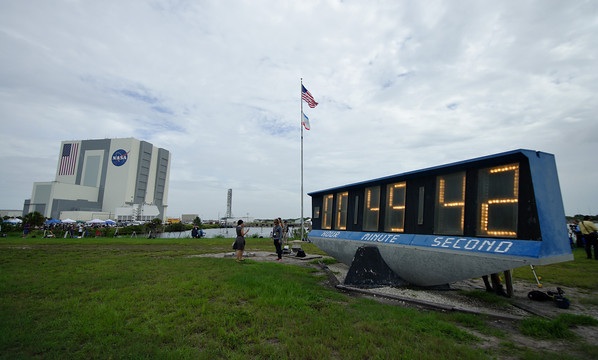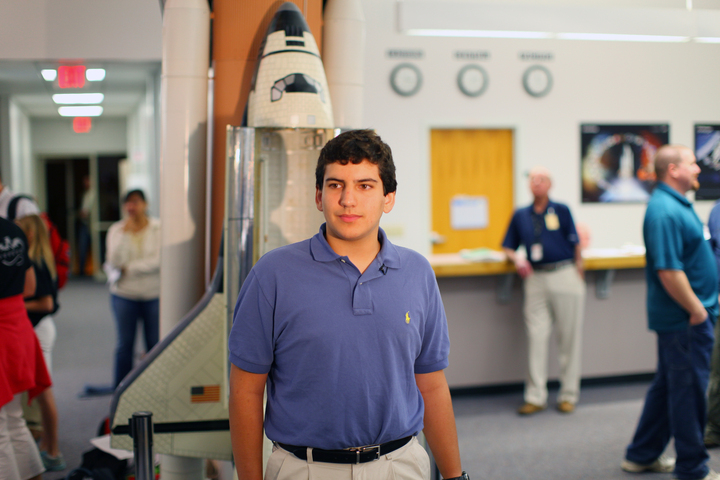 Student Spaceflight Experiments Program (SSEP) Co-Investigator Ryan Puri was part of the delegation from San Marino High School, in San Marino, CA, that was in attendance for the May 19, 2012, launch attempt of the SpaceX Dragon vehicle. The Aquarius payload of SSEP Mission 1 to ISS experiments aboard Dragon included the San Marino experiment: Effect of Microgravity on the Antibacterial Resistance of P. aeruginosa.
Student Spaceflight Experiments Program (SSEP) Co-Investigator Ryan Puri was part of the delegation from San Marino High School, in San Marino, CA, that was in attendance for the May 19, 2012, launch attempt of the SpaceX Dragon vehicle. The Aquarius payload of SSEP Mission 1 to ISS experiments aboard Dragon included the San Marino experiment: Effect of Microgravity on the Antibacterial Resistance of P. aeruginosa.
SSEP Mission 1 delegations were invited by NASA to the Kennedy Space Center Press Site, home of the famous countdown clock, to mingle with reporters from around the world, conduct interviews, and be part of this history-making event. SSEP’s Aquarius was the only science research payload aboard Dragon (see the extensive media coverage of SSEP on Dragon), and Mission 1 student investigators were there to herald in a new era of human spaceflight with Dragon aiming to be the first commerical vehicle to dock with the International Space Station.
While the 4:55 am EDT May 19 launch attempt was aborted 0.5 seconds before launch (here is what we saw at KSC), Dragon was successfully launched 3 days later on May 22, and docked with ISS on May 25. The SSEP experiments payload remained on ISS as Dragon returned to Earth on May 31.
The Aquarius experiments were formally initiated aboard ISS at 10:30 am EDT May 28, 2012, and final operations were conducted 5:42 pm EDT June 29, 2012. Aquarius is scheduled to return to Earth on Soyuz 29 on July 1, 2012, just 19 hours from this writing.
To capture the experience from the perspective of SSEP student researchers, the National Center for Earth and Space Science Education invited essays to be posted on this SSEP National Blog. In his own words, representing America’s next generation of scientists and engineers, here is Ryan Puri’s essay–
A ONCE IN A LIFETIME EXPERIENCE…ALMOST!
Ryan Puri
10th Grade
San Marino High School
Our SSEP experiment was supposed to be taken up to the International Space Station (ISS) aboard the Soyuz 30 Rocket launching from Kazakhstan in March 2012, but as luck would have it, the SSEP Mission 1 experiments were re-manifested to travel onboard the SpaceX Falcon Dragon from the Kennedy Space Center in Florida – a lot closer than Kazakhstan!
Right then and there, my family and I decided we would like to travel from Southern California to Orlando for the launch. As more students expressed their interest in attending the historic launch, NASA invited us all to the NASA Newsroom so we could participate in pre-launch interviews and other activities, as well as meet SpaceX & NASA executives. We would then have the opportunity to view the launch itself from the Press Viewing Area. This was sounding more and more exciting and definitely worth missing a couple of days of school.
The launch was all set for Monday, April 30, 2012 at 12 noon. We would leave on Saturday, and return on Monday so only one day of school would be missed. Then the launch date was changed to Monday, May 7, 2012, at 12 noon. Again, we could travel on Saturday and return on Monday – only one day of school missed. Then the launch date was changed again to Saturday, May 19, 2012, at 4:55am! We now had to travel on Thursday so we would be available Friday for press and other activities, and we could not fly back until Monday. I was now gonna miss 3 days of school with just 2 weeks left in the school year! By this time we had already purchased and changed our plane tickets so it was a go for launch for the Puri family.
We had to be at the rendezvous point at the NASA Press Building at 1:30 am. A bus would then drive the SSEP advisor, students and their families to the NASA newsroom and press viewing area. I didn’t really know what to expect, but it sounded like a long time between arrival and launch – over 3 hours. I was interviewed by NASA TV, the Orlando Sentinel and the Orland Times. I was also the only student selected to speak about my experiment to the SpaceX/NASA Meet & Greet. We also got to meet and talk with NASA Administrator Charles Bolden and the President of SpaceX, Gwynne Shotwell.
Before I knew it, it was time to head out to the Press Viewing Area – a grassy ridge just beyond the giant launch clock. I had felt so lucky that we had been invited to watch the launch up close, but when we got to the top of the ridge, the rocket seemed awfully far away. Still it was exciting to be with all the press in the shadows of the shuttle launch pads – their laptops provided the countdown feed as we all counted down together: 10, 9, 8, 7, 6, 5, 4, 3, 2, 1, Liftoff….nothing!!!
Since we were out in the middle of a dark field, we did not know what was going on and so we all just sat there waiting for a couple more minutes. With no information forthcoming, we trudged back to the newsroom very disheartened – traveled all this way, missed all this school, hung out for hours in the middle of the night, only to have it be a bust! I just wanted to go back to the hotel, get some sleep and then catch the next flight home.
What I did, instead, was hang out in the newsroom until SpaceX announced a press briefing and invited all the students to attend the briefing. At the briefing, the President of SpaceX explained what had happened and announced the date & time of the next launch attempt – Tuesday, May 22, 2012 at 3:55am. She then met with just the SSEP students to invite us to the new launch attempt and to offer to pay for our additional expenses if we could stay.
Okay, so now I wasn’t feeling so disheartened anymore – in fact I was feeling pretty important – that the President of SpaceX, with an aborted launch to deal with, would take the time to worry about us and our experiments. I was also feeling pretty conflicted – should I stay and miss 2 or 3 more days of school – with no guarantee the next attempt would be successful – or should I head back home on Monday as planned?
I wound up watching a perfect launch of the SpaceX Falcon rocket on Tuesday at 12:55 am PST on TV at home with my family. I also later watched the Dragon module, carrying my experiment, dock with the ISS and then was informed via email when Astronaut Don Petit activated my experiment! SPACE…no longer the final frontier for me!!!
SSEP is undertaken by the National Center for Earth and Space Science Education (NCESSE) in partnership with NanoRacks LLC. This on-orbit research opportunity is enabled through NanoRacks LLC, which is working in partnership with NASA under a Space Act Agreement as part of the utilization of the International Space Station as a National Laboratory.
SSEP is the first pre-college STEM (Science, Technology, Engineering, and Math) education program that is both a U.S. national initiative and implemented as an on-orbit commercial space venture.


Comments are closed.